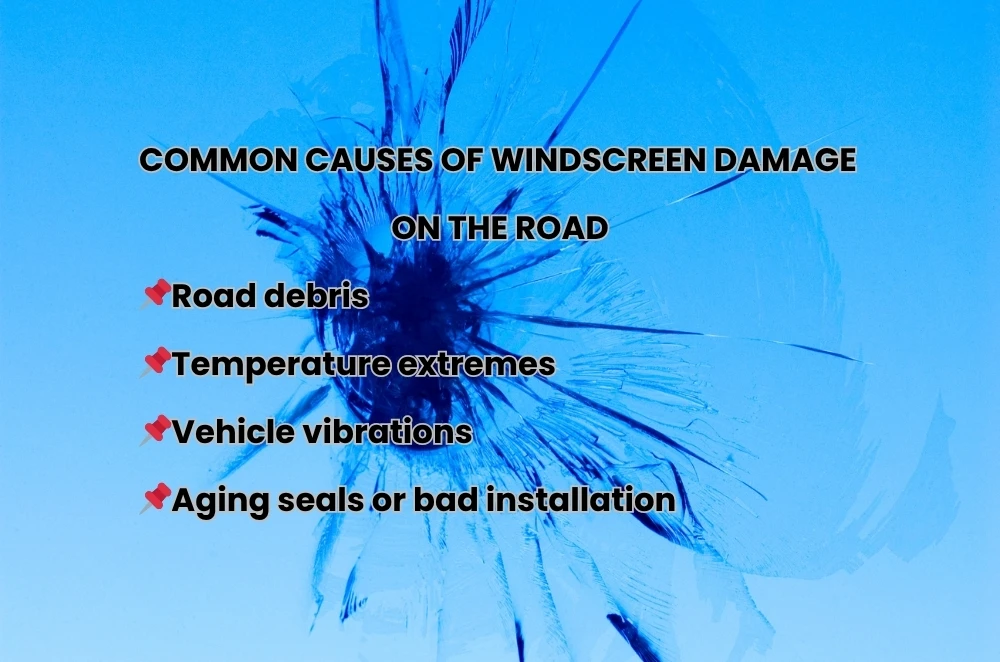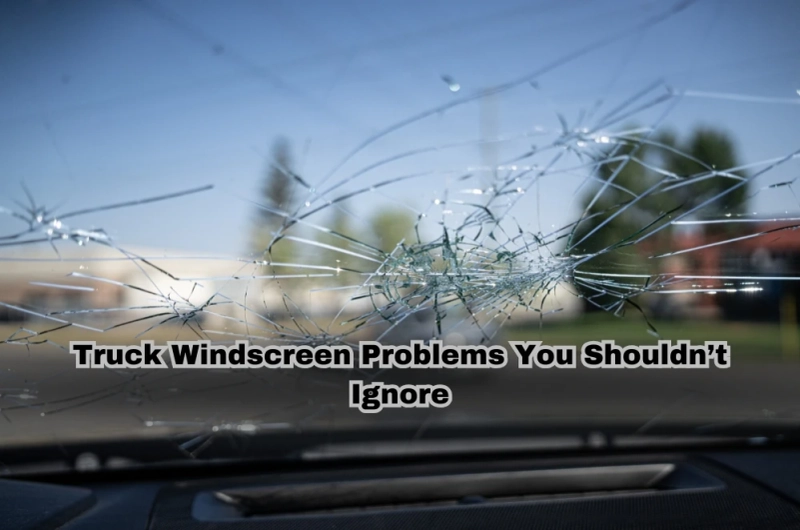There’s a moment almost every truckie has experienced—you spot a tiny chip on your windscreen just before heading off on a run. You think, “I’ll deal with that later.” But then, by the end of the week, that chip has stretched into a crack snaking across your view. I had one go from coin-sized to 40 cm on the Western Freeway just after Ballarat. The sudden temperature drop that morning didn’t help.
That small chip might seem harmless at first, but delaying repairs can lead to dangerous outcomes. Prioritising truck windscreen repair early saves time, money, and possibly lives. Windshields aren’t just about visibility—they’re a key structural component of your truck’s safety system.
Common causes of windscreen damage on the road
Truck windscreens cop a beating, especially in Australia’s rugged conditions. Even a well-maintained vehicle isn’t immune. From flying gravel on the Stuart Highway to sudden cold snaps in the Snowy Mountains, threats come from all angles.

- Road debris: Gravel, stones, and random bits of rubbish kicked up by other vehicles.
- Temperature extremes: Heatwaves followed by downpours can trigger stress fractures.
- Vehicle vibrations: Long hours on uneven roads or unsealed tracks cause pressure on glass edges.
- Aging seals or bad installation: Water ingress or pressure imbalances can cause delamination or edge cracks.
On one occasion outside Kalgoorlie, I noticed the windscreen warping slightly during a long haul. It turns out that heat and an old seal had started to separate the laminate layer.
Why cracks are more dangerous than they look
You might think a crack at the edge of your windscreen won’t affect your driving. But that’s where most drivers are wrong. Even small imperfections compromise your visibility, increase glare at night, and can distort oncoming traffic lights.
There’s also the legal risk. The truck inspection checklist specifically includes windscreen condition in its daily checks. If you’re pulled up for an inspection, even a small crack can lead to compliance issues, fines, or worse—being taken off the road. This is especially important if you're operating in New South Wales, where registering a heavy vehicle comes with strict safety and inspection requirements.
Cracked windscreens can also affect airbag deployment zones and cab stability during rollovers. It’s not just a vision issue—it’s a structural one.
Repair or replace? Here’s how to tell
I used to think every crack meant I’d be up for a full replacement. But that’s not always true. Many issues can be fixed quickly and affordably with resin, as long as you catch them early.
Repairs are generally possible when:
- The damage is smaller than a 20-cent coin
- The chip isn’t in your direct line of sight
- The crack hasn’t reached the glass edge
You’ll likely need a replacement if:
- The damage is deep or has spread
- Multiple chips are present in the same area.
- There’s delamination or discolouration inside the glass layer.s
I once made the mistake of waiting too long to deal with a chip in the corner. By the time I got it looked at, the glass had cracked into the sensor zone and needed a full replacement. It cost me a delivery and a client.
Overlooked risks from driving with damaged glass
It’s easy to brush off small cracks as “manageable.” I’ve done it myself more times than I’d like to admit. But the longer you drive with a damaged windscreen, the more you put yourself and others at risk.
The real danger is gradual distortion. You may not notice how glare spreads at dusk or how your eyes work harder to adjust around a crack. This can cause fatigue on long drives, particularly during overnight hauls.
There are also specific cracked truck glass risks that increase over time:
- Decreased visibility during rain due to water tracking through the crack
- Weakened glass integrity during heavy braking
- Moisture ingress affecting defrost and dashboard electronics.
- Insurance refusal for pre-existing windscreen damage
One mate had his claim denied after a minor rear-end incident, because the insurer saw the damage had been left unrepaired for weeks.
Proactive habits to keep your windscreen safe
A few basic maintenance habits can extend the life of your truck’s windscreen by years. Most of these take less than five minutes but make a huge difference in performance and safety.
Try incorporating these habits into your routine:
- Daily inspections: Before each trip, use a torch and check for chips under good light.
- Keep your distance: Especially when following earthmovers, trailers, or construction vehicles.
- Replace wipers regularly: Old blades scratch the glass and trap debris.
- Use safe cleaning products: Avoid chemicals that erode the protective film or rubber seals.
- Park smart: Shade helps reduce sudden thermal expansion that causes stress fractures.
I learned this the hard way after leaving my truck parked facing the sun all weekend—Monday morning revealed a neat diagonal crack from top to bottom.
What to do when damage strikes mid-route
Windscreen damage can strike when you least expect it. If a chip or crack appears while you're on the road, don’t panic—but do act quickly.
First, assess the crack from inside and out. Is it spreading? Is it near the driver's view? If it’s still small and safe to continue, apply tape over the interior side to reduce vibrations and moisture seepage. Document the damage with clear photos—this can help with insurance or when booking repairs through your company.
Don’t wait to handle it at the end of your run. I once ignored a small chip on a loop through the Riverina, and by the next job, it had widened enough to require a complete windscreen change, costing me two days in the yard.
There’s a handy breakdown of how to deal with different types of glass damage in a truck windscreen. It covers smart decisions, repair timing, and tech upgrades worth knowing.
Final thoughts—damage won’t fix itself
Here’s the truth: windscreen problems don’t go away. They worsen. And by the time they interfere with your line of sight or fail an inspection, it’s already too late. I’ve learned from experience that it’s always better to fix early and stay ahead of the curve. Replacing a windscreen at the depot might feel like a hassle, but it beats dealing with a shattered pane 500 km from home or being grounded at a weigh station. Cracks aren’t just a blemish—they’re a growing liability. If you're on the road day after day, your windscreen is one of your most important assets. Learn to maintain truck windscreens—treat them like one.


